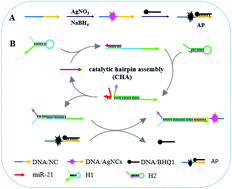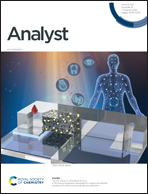Enzyme-free amplified detection of miRNA based on target-catalyzed hairpin assembly and DNA-stabilized fluorescent silver nanoclusters†
Abstract
MicroRNAs (miRNAs) have been shown to be promising biomarkers for disease diagnostics and therapeutics. However, the rapid, low-cost, sensitive, and selective detection of miRNAs remains a challenge because of their characters of small size, vulnerability to degradation, low abundance, and sequence similarity. Herein, we describe an enzyme-free amplification platform, consisting of a catalytic hairpin assembly (CHA) and DNA-templated silver nanoclusters (DNA/AgNCs), for miRNA analysis. In this work, two DNA hairpins (H1 and H2) were first designed for target miR-21-induced CHA, and then the fluorescence of DNA/AgNCs was quenched by BHQ1 to construct an activatable probe (AP). In the presence of target miR-21, hairpin H1 was opened by miR-21 through a hybridization reaction, and hairpin H2 was then opened by H1. During this process, miR-21 was released from H1 and participated in the next round of hybridization, triggering the CHA cycle reaction. The obtained H1–H2 products with sticky ends could react with the AP, forcing BHQ1 away from the DNA/AgNCs and thus causing the fluorescence recovery of the DNA/AgNCs. The assay for miR-21 detection demonstrated an excellent linear response to concentrations varying from 200 pM to 20 nM with the detection limit of 200 pM. The simple and cost-effective strategy holds great potential for application in biomedical research and clinical diagnostics.



 Please wait while we load your content...
Please wait while we load your content...